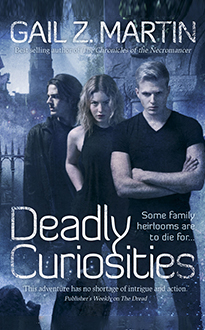By Gail Z. Martin
In my new book Deadly Curiosities, Cassidy Kincaide is the proprietor of Trifles and Folly, a 350 year-old antique and curio shop that exists to get dangerous magical items off the market. Behind the idea of antique shops and shows, flea markets, swap meets, even garage sales, lies the concept of the collector, the person who is continually seeking that perfect piece to complete a set, or who wants to have the biggest and best assortment of something.
Why do we collect what we collect, and what does it say about us?
My father was a collector and a hoarder. I grew up going to antique shows, curio shops, flea markets, used book stores (the musty kind, not the cool kind) and any gathering where old stuff was for sale. And I never cease to be amazed at what people collect.
At various times, my dad collected old VW Beetles, antique steam engines (the huge ones from sawmills), Native American artifacts, books about the Old West, Baby Ben alarm clocks, Smith-Corona typewriters, old Singer sewing machines, 1920s oscillating fans and bear traps. Yes—bear traps.
When it came time to clean out his stash after he went into a nursing home, I had the chance to think a lot about collectors and collections. Not everyone lets theirs get as far out of hand as my father did, and unless it takes over your life, collecting can be a fun hobby. But why do we collect things, and what makes us pick particular collections?
I can’t back this up with more than anecdotal evidence, but I suspect that nostalgia heavily influences the choice of collection. As we dug through all the things dad bought, I could link many of them to stories he had told about things he remembered from his childhood. The Baby Ben alarm clock from his grandmother’s house—he had over 100 of them. The treadle Singer sewing machine from the early 1900s that his mother had used when he was a child—45 of those. The steam-powered engines he remembered from his youth working on a neighbor’s farm, the Model-T Ford from his childhood, and the Native American artifacts and Old West books that reminded him of listening to The Lone Ranger on the radio…he had them all.
Collecting involves strong emotions. Consciously or not, I think many collectors pick items that take them back to a happy or safe memory or a pleasant time in their past. Maybe the object reminds the collector of a beloved person, or a favorite place, or a less complicated time in life. Seeing, touching or using the objects sparks that momentary connection, that flash of dopamine in the brain that is comforting in a very deep way.
I think the same factors are at work when we decide what to keep and what to throw away. The concert ticket from a special date, the trinket you picked up on a favorite vacation, the crayon-scrawled picture from a child now grown—these also cause that hit of happy juice to the brain as one-of-a-kind treasures.
Which brings me back to Deadly Curiosities. Cassidy is a psychometric, able to read strong emotions and memories by touching objects. Not all objects have a resonance, but those that do usually pack a psychic wallop. Many of the antiques and curios that find their way into Trifles and Folly have supernatural qualities as well, including dangerous dark magic. It’s up to Cassidy and her team to get those objects off the market and keep them out of the wrong hands.
Think about the way you feel when you pick up a memento that reminds you of a particularly special time. Now imagine having that feeling augmented by magic, being able to re-experience that moment as if you were there, even for someone else’s memories. Most of us keep knick-knacks that remind us of the good times. Many of the objects that find their way into Trifles and Folly hold the resonance of tragedy, evil or supernatural mayhem.
So the next time you see a tempting object at an antique shop or yard sale, scan how you feel when you handle it. Because as Cassidy Kincaide knows, everyday objects can have a dark side.










